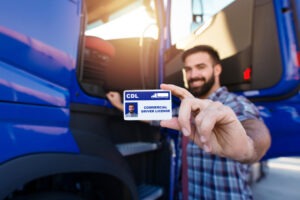
The main difference between a commercial and a non-commercial driver’s license is that a commercial license is used for business purposes, while a non-commercial license is used for personal activities.
If you’ve been involved in a truck accident, you may be overwhelmed by injuries, medical bills, and complicated insurance claims. A Los Angeles truck accident lawyer can take on your case and help you pursue the compensation you deserve.
What is the Difference Between a CDL and a Non-Commercial Driver’s License?
The differences between a commercial and non-commercial driver’s license pertain to the types of automobiles you can drive and the licensing requirements you must meet.
- A commercial driver’s license (CDL) is required to operate large, heavy, or hazardous materials vehicles used for business purposes, such as tractor-trailers, buses, and tankers.
- A non-commercial driver’s license is used for personal vehicles, including cars, motorcycles, and small trucks.
To obtain a CDL, you must undergo specialized training and skills testing. Since it’s only used for personal cars, a non-commercial license only requires a standard written test and a basic road skills test.
What is the Difference Between a Commercial and Non-Commercial Vehicle?
Commercial and non-commercial automobiles serve different purposes. A commercial vehicle is primarily used for business activities, such as transporting goods or passengers for profit. Examples include delivery trucks, semi-trucks, and charter buses.
Non-commercial vehicles, like family cars or motorcycles, are intended for personal use.
Commercial trucks often exceed the size and weight limits for non-commercial vehicles and may require special equipment or endorsements to operate. Additionally, commercial vehicles are subject to federal regulations, such as those enforced by the Department of Transportation (DOT).
What is the Difference Between Commercial and Non-Commercial Use?
Whether a vehicle is designated for commercial or non-commercial use depends on the purpose of its operation.
Commercial use involves activities related to business or profit-making, such as delivering goods, providing transportation services, or operating machinery on behalf of a company. Non-commercial use pertains to personal activities like commuting or family trips.
Commercial use often necessitates additional insurance and compliance with regulations, as well as a CDL.
What is the Maximum Weight for a CDL Truck?
According to federal law, the maximum weight for a semi-truck and trailer combination in the United States is 80,000 lbs.
In general, a CDL is required for single vehicles with a Gross Vehicle Weight Rating (GVWR) of 26,001 pounds or more. Specialized endorsements may be required for vehicles transporting hazardous materials or exceeding specific weight limits.
Types of Commercial Driver’s Licenses
Three classes of commercial driver’s licenses dictate the types of automobiles you’re allowed to drive. Those classes are Class A, Class B, and Class C.
Class A CDL
A Class A CDL permits the holder to operate combination vehicles with a combined GVWR of 26,001 pounds or more, provided the towed vehicle exceeds 10,000 pounds.
This license is commonly required for drivers of tractor-trailers (such as tow trailers and livestock trailers), flatbeds, and other large vehicles.
Class B CDL
A Class B CDL allows the operation of single vehicles with a GVWR of 26,001 pounds or more or the towing of a vehicle weighing 10,000 pounds or less.
This license is suitable for operating buses, dump trucks, and large delivery vehicles.
Class C CDL
A Class C CDL is for drivers operating passenger vehicles designed to transport 16 or more people (including the driver), as well as vehicles carrying hazardous materials.
Examples of class C vehicles include passenger vans and small HAZMAT vehicles.
What are the Advantages of a CDL?
Obtaining a CDL offers many benefits, including:
- Higher earning potential: CDL holders qualify for numerous well-paying jobs in trucking, logistics, and transportation that regular drivers don’t.
- Job security: The demand for skilled drivers remains high in industries like freight and public transportation.
- More opportunities: A CDL enables you to work with specialized automobiles, such as tankers, buses, and heavy machinery.
- Skill development: Training for a CDL equips drivers with advanced skills and knowledge for safer truck operation.
What is the Application Process for a Commercial Driver’s License?
The primary difference between a commercial and non-commercial driver’s license is what you must do to obtain them. The licensing process for a CDL involves the following steps:
- Meet eligibility requirements: Ensure you meet the minimum age requirements (usually 18 for intrastate and 21 for interstate driving) and possess a valid non-commercial driver’s license.
- Submit an application: Submit a CDL application to your state’s Department of Motor Vehicles (DMV).
- Pass a medical examination: To obtain a DOT medical certificate, you must pass a physical examination to prove your fitness to operate commercial vehicles.
- Obtain a commercial learner’s permit (CLP): Pass a written exam to receive a CLP, or provisional license, which will enable you to practice driving commercial vehicles under supervision.
- Complete CDL training: Enroll in a certified CDL training program to gain practical experience.
- Pass the CDL skills test: Demonstrate your ability to operate a heavy vehicle safely and efficiently by passing a road test.
What are the Testing Requirements for a CDL?
CDL testing requirements vary by state, but they generally include:
- Knowledge test: A written exam covering topics like vehicle operation, safety protocols, and federal regulations.
- Skills test: A three-part evaluation that includes a pre-trip inspection, basic vehicle control, and an on-road driving test.
- Endorsements: Additional tests may be required for specialized endorsements, such as hazardous materials (HAZMAT), passenger transport, or tankers.
How Much Does a Commercial Driver’s License Cost?
The cost of obtaining a CDL varies by state. That said, you’ll typically need to pay fees for:
- Application: This fee typically ranges from $50 to $100.
- Knowledge and skills tests: This fee often ranges between $20 and $50 per test.
- Training: CDL training programs can cost anywhere from $1,000 to $8,000, depending on the program’s length and intensity.
- Endorsements: You may have to pay additional fees for endorsement tests, such as HAZMAT.
- Medical examination: DOT physical exams usually cost between $50 and $200.
How Do You Renew a CDL?
To renew a CDL, you’ll need to complete the following steps:
- Check renewal requirements: Review your state’s specific guidelines and timelines.
- Provide documentation: Submit proof of identity, residency, and your current CDL.
- Pass a medical examination: If necessary, update your DOT medical certificate.
- Pay the renewal fee: Renewal fees typically range from $50 to $150, depending on your state.
- Complete additional tests: Some states may require refresher tests or updated endorsements.
Contact a Truck Accident Lawyer Today
If you’ve been in an auto accident caused by someone else’s negligence, you don’t have to defend your rights alone. An experienced truck accident attorney from Omega Law Group Accident & Injury Attorneys can handle your case and help you pursue justice.
Don’t wait to seek legal help. Schedule a free consultation to speak to a lawyer today.




